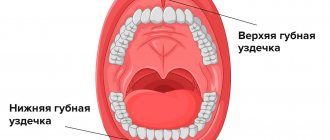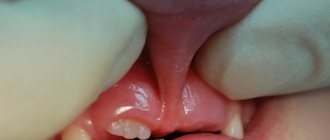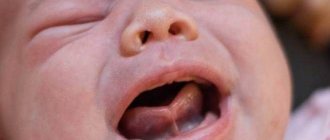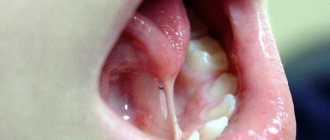When is tongue frenulum trimming required?
The frenulum of the tongue is a small elastic membrane connecting the tongue to the oral cavity. The frenulum is responsible for important functions of the tongue: movement, breathing, swallowing, speech. This disorder is called ankylogloxia.
The normal development of the lingual frenulum begins centrally, at the root of the tongue, and ends at the lower incisors. The rest of the arrangement is a deviation. There are several deviations in the development of the frenulum:
- Short bridle. The tongue becomes inactive and leads to improperly formed speech and jaw deformation.
- Incorrectly positioned frenulum. Reduces motor activity of the tongue.
- Long frenulum under the tongue. It can be located at the tip of the tongue and affect the swallowing process, disrupting nutrition.
Problems with the development of the tongue frenulum are a congenital pathology. And it is hereditary in nature. May occur due to problems during pregnancy.
Trimming the frenulum for an adult
The operation to trim the frenulum of the tongue can be performed at any age as prescribed by a doctor.
Every 20th person has a shortened frenulum of the tongue. The likelihood of this anomaly occurring in men is much higher than in women.
To independently check how the frenulum is located under the tongue, you can do simple children’s exercises: “horse”, “mushroom”, “painter”. Externally, the frenulum will not differ from a healthy state. If you experience any discomfort while performing these exercises, you should go to the clinic for a consultation.
Symptoms that will help you identify problems with tongue webbing:
- When the tongue is extended, the tip of the tongue bends down;
- Difficulty swallowing;
- It is not possible to insert the tongue completely;
- Bite problems;
- Inflammation of the surrounding tissues of the tooth;
- When the tongue is raised, it takes the shape of a heart;
- Incorrect pronunciation of words.
Adults require frenulum trimming less often than small children. However, tissue healing in an adult takes a little longer than in small children. This type of operation is performed under local anesthesia.
When is surgery scheduled?
The frenulum circumcision operation is performed for the following indications:
- Impaired pronunciation of words. If the speech therapist did not notice the deviation in childhood, then speech defects may occur in adulthood. The operation will help restore the functioning of the speech apparatus.
- Orthodontist recommendations. A frenulum that is too short causes crooked teeth and stunts the growth of the lower jaw.
- Periodontal recommendations. Due to deformation of the gums, the root of the tooth is exposed, which makes it susceptible to other diseases.
When not to have surgery
Since all surgical procedures have limitations. If you have:
- acute chronic diseases of the oral cavity;
- benign tumors of the jaw tissue;
- infectious diseases of the whole body;
- poor blood clotting;
- mental disorder;
The operation to trim the frenulum of the tongue is called frenuloplasty.
Types of frenuloplasty
This type of operation can be performed in 3 ways:
- Cutting. The bridle is trimmed, the edges of which are sewn with transverse seams.
- Delete. The frenulum is trimmed using two triangular incisions and removed, after which sutures are applied.
- Moving. The edge of the frenulum is trimmed and secured in the required place with sutures.
The entire operation takes no more than 20 minutes. After a few days, the stitches will dissolve on their own. There are no complications after frenuloplasty.
What is the problem with the incorrect structure of the frenulum of the tongue?
In infants, an abnormal frenulum structure can cause difficulty sucking. In this case, the problem is solved in the maternity hospital by pruning. If the baby is still able to eat normally, doctors try to leave the situation alone, giving, as they say, time to grow. Indeed, in many cases, along with the growth of the jaw, the frenulum gradually stretches and takes on a normal shape.
In older children, a short hyoid frenulum creates some speech therapy difficulties:
- Difficulties arise with the pronunciation of hissing sounds.
- Correct reproduction of sonorants is not possible.
To pronounce the so-called upper lingual sounds, you need to raise the tip of your tongue upward. An insufficiently elastic bridle prevents this from being done.
However, it is very important to understand that it is not “responsible” for all speech problems. So if a child has a delay in speech development, syllables and sounds are “confused” in speech, a limited vocabulary or other problems, a short frenulum has nothing to do with it. The speech therapist will suggest effective methods of correction.
Preparing for surgery
Before the procedure, it is necessary to perform a number of preparatory measures:
- Consult a specialist.
- Perform diagnostic tests.
- At least 2 weeks before surgery, donate urine and blood for analysis, undergo testing for blood clotting, viral hepatitis, and HIV.
- Adult patients should undergo fluorography and, if necessary, an electrocardiogram.
- Take a test for an allergic reaction to the drugs used.
- Immediately before the operation, it is better to eat a hearty meal, since after the procedure this will not be possible for several hours.
- Perform professional oral hygiene and treat it with an antiseptic.
Methods of plastic surgery of the frenulum of the tongue
- Frenotomy (transverse intersection). This is the easiest way to correct the frenulum, with which you can correct the small thickness or width of the organ.
- Frenectomy (removal of a fragment of the frenulum). The method is used when the thickness and width of the hyoid fold is too large.
- Frenuloplasty (cutting and relocation). The technique helps to get rid of the pathology of fusion of the frenulum with the floor of the mouth or lower lip.
Frenotomy and frenectomy are fairly simple techniques that can be performed with a scalpel or laser. Frenuloplasty requires certain skills from the surgeon. The more preferable method of performing tongue frenuloplasty is the laser technique. Using a laser has a number of advantages:
- Speed of the procedure.
- No need for stitches.
- No bleeding during surgery.
- Instant disinfection of the cut surface.
- No scars after plastic surgery.
- Fast and comfortable recovery period.
Laser correction is often used in children, since surgical instruments that frighten the child are not used during the procedure. In addition, wound healing occurs much faster than after using a scalpel.
The frenuloplasty lasts no more than 30 minutes. Children need to remain calm for at least 15 minutes.
Recovery period
After plastic surgery of the frenulum of the tongue, in most cases, experts give the following recommendations for effective recovery:
- Do not eat or drink for several hours after the intervention. Drinking water is allowed.
- Visit your doctor as scheduled.
- Avoid eating hard and spicy foods while the wound is healing.
- Perform oral hygiene thoroughly and regularly. After each meal, rinse with an antiseptic solution.
- Do the exercises that the doctor tells you about.
Is it painful to perform lingual frenuloplasty?
Many parents worry about anesthesia, since tongue frenulum correction is mostly performed on children. Experts reassure: there will be no pain, since high-quality local anesthesia is used during plastic surgery. If the operation is performed with a laser, then you can do without anesthetics altogether. This technique is used in newborns. If pain relief is necessary, topical anesthetics in the form of gels, sprays, and ointments can be used.
Methods for fixing the problem
Correction of lip frenulum is carried out on an outpatient basis, under the influence of conduction or local infiltration anesthesia.
There are three ways:
1. Dissection of the frenulum (frenulotomy) – the frenulum is dissected with a transverse incision, which is pulled together and stitched in the longitudinal direction.
2. Excision of the frenulum (frenulectomy) - the frenulum is stretched using a clamp and then excised between the front teeth. The mucous membrane bordering the incision is peeled off, while the edges of the wound are brought closer to each other by bringing them together and stitching them together.
3. Frenuloplasty consists of moving the place of attachment of the frenulum: a median vertical incision is made, at both ends of which additional incisions are made at an acute angle. Triangular flaps peel off and counter movement occurs. They are stitched together horizontally.
Possible complications
Plastic surgery of the frenulum is a simple operation, but still it does not exclude the occurrence of complications:
- Development of the inflammatory process. This complication is most likely, since the oral cavity is filled with various microorganisms and can cause infection. In this case, symptoms such as fever, local swelling, suppuration and pain are usually observed.
- Soreness. This consequence is normal. It is associated with soft tissue injury and can be aggravated by eating and drinking. In these situations, it is recommended to resort to the use of painkillers.
- Formation of a rough scar. This consequence of the operation is the result of refusal to perform tongue exercises.
- Increased body temperature. This symptom is a normal variant in children. If present, anti-inflammatory drugs may be prescribed. Body temperature should return to normal in 2-3 days. If this does not happen, then you should contact a specialist.
- Discomfortable sensations in the presence of stitches. Negative feelings usually disappear after a couple of days.
- Smacking in babies. The symptom is alarming, as it may indicate improper latching of the breast or nipple. Smacking that does not disappear after 3 days indicates a medical error.
- Seams coming apart. To avoid such a complication, it is necessary to ensure that the child does not fall or talk too much and actively. Also, you should not look into the child’s mouth, pulling the tongue too far. If the stitches come apart, you should immediately consult a doctor.
- Formation of white plaque on the wound surface. Do not be alarmed, plaque is not pus, but indicates epithelialization. But there should be no swelling, fever or other symptoms of poisoning. The plaque does not require cleansing; it will disappear on its own by the time it is completely healed.
- The tongue will remain numb and swollen for some time after the procedure. This is due to the fact that the effect of the anesthetic has not yet completely worn off. All these symptoms disappear within one day.
Parents of small children and adult patients should not worry about plastic surgery of the lingual frenulum. This procedure does not pose a health hazard and is very easy to tolerate. You can go to the World of Dentistry clinic with a “light” heart, since we employ qualified surgeons who know their business.
After operation
As a rule, there are no complications after trimming the frenulum of the upper, lower lip or tongue, and recovery takes only a few days. When the operation is performed, it is best to feed the baby immediately, since mother's milk acts as a pain reliever. Adult patients should temporarily avoid hard and sticky foods. If there are problems with speech, then special sessions with a speech therapist are necessary. The slight discomfort caused by the sutures will go away on its own after they are absorbed, that is, after 4-5 days, maximum in a couple of weeks.
Lump under the tongue on the frenulum
In some cases, problems with tongue mobility and the sensation of a foreign body under it are not necessarily related to the size of the frenulum. The fold is of normal length, but a small white ball is found on or near it. This is how the inflammatory process in the mouth manifests itself. However, the presence of a shortened frenulum, on which food debris accumulates, significantly increases the likelihood of developing an infection.
If a lump appears under the frenulum, you need to contact your dentist to accurately determine the cause and effectively eliminate the problem. If necessary, after treatment of inflammation, fold plastic surgery is performed.
How to check if a child has a short frenulum
The presence of difficulties with the frenulum can be easily determined independently:
- Open your mouth slightly and place the tip of your tongue in the area behind your upper teeth. In this position, the place of attachment of the frenulum is clearly visible. If it is not “where it needs to be,” it is difficult to lift the tongue up.
- Pull your tongue forward. A short frenulum does not allow this to be done; in addition, the tip of the tongue visually looks forked
- Open your mouth and try to touch your upper lip with your tongue and lick it. Difficulties with the bridle make this movement difficult to perform.
Please note: sometimes a child cannot cope with these exercises not because there is something wrong with the frenulum. The cause may be weak muscles of the articulatory apparatus. Take a clean handkerchief and try to help your tongue. If resistance is felt when moving, then the problem is still in the hyoid frenulum.
Rehabilitation period
Recovery after the procedure takes 3-4 days, and even less when working with a laser. Recommendations during the rehabilitation period:
- Refusal to eat for 2-3 hours after the procedure
- Avoiding hot, spicy, sour foods for several days
- Avoiding hot drinks for a day
- Limiting solid foods while healing
- Rinsing the mouth with antiseptics
- Using healing ointments
The doctor gives detailed recommendations and prescriptions on an individual basis.
Frenum of the lower lip
Dentists say that not all babies have a frenulum on the lower lip; it may be completely absent or forked. To study the length of the frenulum, the same technique is used as for studying the frenulum of the upper lip. Normally, the frenulum should be thin and attached in the middle of the body of the jaw. An important condition is that the frenulum of the lower lip must coincide with the center line between the incisors. If these conditions are not met, the bridle is short.
A short oral frenulum interferes with breastfeeding, as the baby cannot properly latch onto the mother's nipple. Fortunately, this situation is quite rare; the most typical manifestation of a short frenulum in the oral cavity is the presence of inflammatory gum diseases in the area of the lower incisors and malocclusion according to the same principle as in the upper jaw.
There are no age restrictions when excision of the mandibular frenulum; usually the mandibular frenulum is diagnosed and corrected at approximately the same time. The principle of the operation is similar to correction on the upper jaw.








